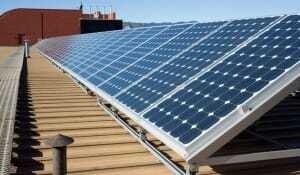Solar power and fishing share the same sparkle: Like fish in the sea, sunlight is free. But just as a handful of “free” salmon caught outside the Golden Gate Bridge might easily cost $200 a fish to actually catch, converting sunlight to power remains about as economical as fishing from an aircraft carrier.
We just concluded our first year of operating a solar-energy system—a rooftop array of photovoltaic cells—on a mixed-use project in Palo Alto, California. Either we bought the worst lemon since God created fruit or, contrary to green gospel, solar systems are not paying off like broken slot machines.
Here are our actual numbers: We paid $187,623 in 2012 for a state-of-the-art solar-energy system. We received a state rebate of $54,263 and a federal tax credit of $40,008, reducing our net cost to $93,352. Over the last 12 months, we have averaged $350 a month in electricity cost savings; annualized, this equals 4.49 percent of our $93,352 investment. If we were happy just to get our original money back (we would be—in real estate, this is known as a home run), it would take about 22 years. If we wanted just a 5 percent return—not exactly reaching for the stars—we would need more than 100 years to achieve it.
We have been assured that our system is running properly and that it hasn’t been a particularly cloudy year in Palo Alto. The system is presumably operating at peak efficiency; though, more like tennis players than wine, solar systems don’t improve with age.
The solar company that fabricated and installed our system estimated we would save $6,571 in annual electricity costs. This estimate proved 56 percent higher than our actual experience. The company prepared a spreadsheet that sets forth our estimated return on its system over the next 30 years. Much as developers project highly rosy—and even more highly suspect—future profits by forecasting robust rent increases, this spreadsheet assumes that energy costs will rise 5 percent a year over the next 30 years. This assumption does create a decent long-term return, but ignores the likelihood that if energy costs quadruple, so will inflation and thus our repayment would be in dollars worth a fourth as much, wiping out any real return.
Reliable third-party numbers on solar-power economics are about as easy to track as a snow leopard. If one ignores the solar companies themselves for fear of bias and instead focuses on papers published by nonprofit groups, the numbers are still singularly unhelpful, hidden in a thicket of obscure math and wishful thinking.
The first obstacle one encounters in this quest is that short of a degree in electrical engineering, the assumptions, jargon, and methodology used to explain solar financial returns are, simply put, beyond understanding.
More important, the research appears to be written by true believers. In the long run, it is not the con artist who does one the most damage—the reasonably bright man or woman sees through him in a single meeting. It is instead the true believer who, absolutely persuaded himself, will convince you to invest in his played-out gold mine or his almost-free energy system. The Clean Energy Group, a nonprofit advocate, says on its website, “Several studies have shown that the average re-sale value is increased for properties with renewable energy systems. There can be as much as a $20 increase in property value for every $1 of annual energy cost reduction realized from renewable energy systems.”
This statement is misleading in such a sweet, hopeful way as to cause one to suspect that—rather than intending to fib or overstate—its authors simply understand nothing about business. Yes, a solar energy system that lowers operating costs and increases net income may raise a property’s value, but the authors ignore the system’s cost; a $100,000 increase in property value from a $200,000 energy system is but another on-ramp to the road to financial ruin. And any income gain may be more than offset by required maintenance and repairs to the system. (Have you ever noticed how many of those windmills at Altamont Pass are inoperative at any given time?)
Everyone wants solar power to succeed, and maybe one day it will. But if it’s going to rise beyond its current status as an expensive green boondoggle—if the science is going to advance to where solar energy is truly an economic investment—sharing its real cost and limitations today is essential. Each developer burned by solar power will complain to his industry associates. And they, in turn, will avoid making his mistake—at the cost of the greater mistake of refusing solar energy when it finally does make financial sense.
Reprinted with permission by The Registry SF .





